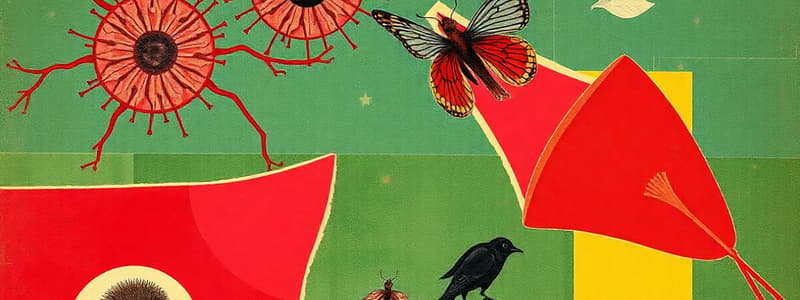Podcast
Questions and Answers
What is the primary function of the cell wall in plant cells?
What is the primary function of the cell wall in plant cells?
- Storing nutrients and waste products
- Regulating gene expression
- Transporting substances across the membrane
- Protecting and providing structural support (correct)
Which component is NOT found in the plant cell wall?
Which component is NOT found in the plant cell wall?
- Pectin
- Cellulose
- Chitin (correct)
- Lignin
What is the primary function of chloroplasts in plant cells?
What is the primary function of chloroplasts in plant cells?
- Storage of proteins and lipids
- Storage of starch and photosynthesis (correct)
- Production of ribosomes
- Synthesis of RNA and DNA
How does the cell membrane function in cellular transport?
How does the cell membrane function in cellular transport?
Which type of plastid is responsible for the storage of proteins, lipids, and starch in non-photosynthetic tissues?
Which type of plastid is responsible for the storage of proteins, lipids, and starch in non-photosynthetic tissues?
What vital role does the central vacuole play in mature plant cells?
What vital role does the central vacuole play in mature plant cells?
What role does the nucleus play in eukaryotic cells?
What role does the nucleus play in eukaryotic cells?
Which statement about the centrosome is incorrect?
Which statement about the centrosome is incorrect?
What is the primary purpose of ribosomes in a cell?
What is the primary purpose of ribosomes in a cell?
What is the main function of the nucleus in a cell?
What is the main function of the nucleus in a cell?
Flashcards
Nucleus function
Nucleus function
Stores DNA for cell division, metabolism, and growth.
Nucleolus function
Nucleolus function
Makes ribosomes, cell's protein factories.
Plastid function
Plastid function
Membrane-bound organelles with DNA; store starch and photosynthesize (in some types like chloroplasts).
Chloroplast function
Chloroplast function
Signup and view all the flashcards
Central Vacuole function
Central Vacuole function
Signup and view all the flashcards
Centrosome function
Centrosome function
Signup and view all the flashcards
Cell Wall (plant)
Cell Wall (plant)
Signup and view all the flashcards
Cell Membrane function
Cell Membrane function
Signup and view all the flashcards
Endoplasmic Reticulum (ER)
Endoplasmic Reticulum (ER)
Signup and view all the flashcards
Golgi Apparatus function
Golgi Apparatus function
Signup and view all the flashcards
Study Notes
Biology 8 - Unit 2: Life Processes of Living Things - Cells
- The unit covers cell structure and functions.
- The theme for the course is Live 5Cs (Competence, Character, Commitment to Achieve, Collaboration, Creativity).
- The 5Cs will be achieved through academic rigor, growth mindset, and grit.
Characteristics of Organisms
- Organisms are made of cells.
- Organisms require energy (food).
- Organisms reproduce (species).
- Organisms maintain homeostasis.
- Organisms are organized.
- Organisms respond to the environment.
- Organisms grow and develop.
- Organisms exchange materials with their surroundings (water, wastes, gases).
Levels of Organization
- Non-living levels: atom, molecule, organelles, (etc).
- Living levels: cell (makes up all organisms), tissue, organ, organ system, organism.
- Living levels (bigger scale): population, community, ecosystem, biome, biosphere (all living and non-living things on Earth).
Cell Theory
- All living things are made of cells.
- Cells are the basic unit of structure and function in an organism (basic unit of life).
- Cells come from the reproduction of existing cells (cell division).
Number of Cells
- Organisms can be unicellular (composed of one cell) or multicellular (composed of many cells).
- Multicellular cells may organize into tissues, etc.
- Cells in multicellular organisms can specialize (take on different shapes and functions).
- Examples of unicellular organisms include amoeba, bacteria, and paramecium.
- Examples of multicellular organisms include plants and animals.
Cell Specialization
- Cells in multicellular organisms specialize.
- Specialization occurs by turning specific genes on and off.
- This process is called differentiation.
- Examples of specialized animal cells include muscle cells, red blood cells, and cheek cells.
- Examples of specialized plant cells include guard cells and xylem cells, and pollen.
Kinds of Cells
- Prokaryotes (the first cells): lack a nucleus or membrane-bound organelles.
- Includes bacteria.
- Simplest type of cell.
- Single, circular chromosome.
- Eukaryotes: contain 3 basic cell structures: nucleus, cell membrane, and cytoplasm with organelles.
Prokaryotes vs. Eukaryotes
- A comparison chart shows the differences.
Two Types of Eukaryotic Cells
- Plant cells vs animal cells
- Plant cells have a cell wall, unlike animal cells.
Organelles
- Very small (microscopic).
- Perform various functions for a cell.
- Found in the cytoplasm.
- May or may not be membrane-bound.
Organelles of Animal Cells
- Includes cell membrane, nuclear membrane, nucleus, mitochondrion, lysosome, cytoplasm, ribosomes, centrosome
Organelles of Plant Cells
- Includes cell wall, cell membrane, central vacuole, nucleus, mitochondrion, chloroplasts, plastids (including leucoplast, chromoplast), cytoplasm, ribosomes, Golgi apparatus
Cell Membrane
- Composed of a double layer of phospholipids (phospholipids bilayers) and proteins.
- Surrounds all cells.
- Controls what enters or leaves the cell.
Cell Division
- This is a next topic, but no details are given.
Studying That Suits You
Use AI to generate personalized quizzes and flashcards to suit your learning preferences.



